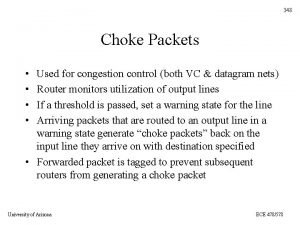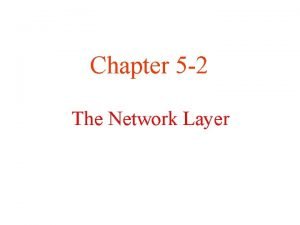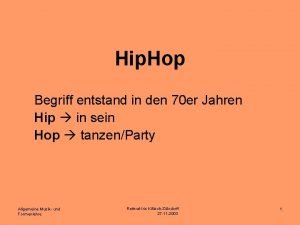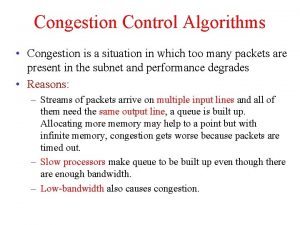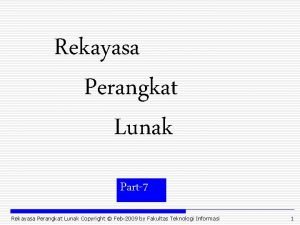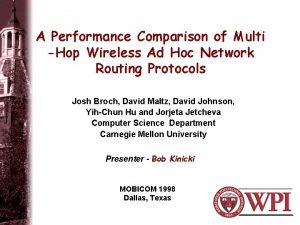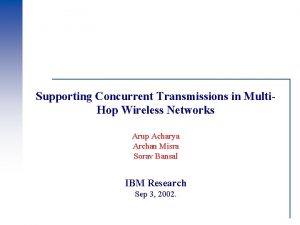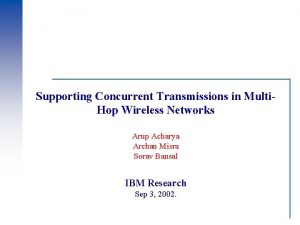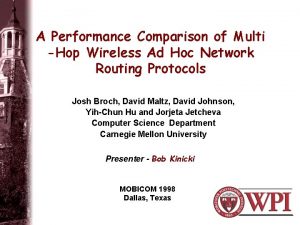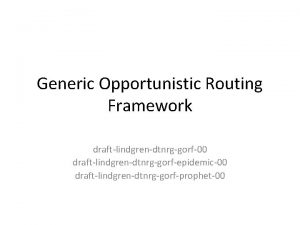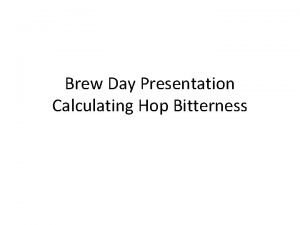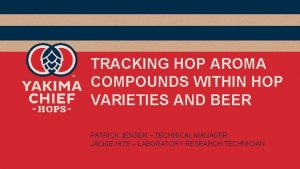Ex OR Opportunistic Multi Hop Routing For Wireless
















- Slides: 16

Ex. OR: Opportunistic Multi. Hop Routing For Wireless Networks Sanjit Biswas and Robert Morris MIT CSAIL http: //pdos. csail. mit. edu/roofnet

What is Ex Opportunistic Routing ? Ø Ø Ø A Link/Network Layer diversity routing technique that uses standard radio hardware Achieves substantial increase in throughput for large unicast transfers in mesh network. Thoughts : Ø Ø Ø Does opportunistic mean Greedy ? Do we need Dijkstra’s algorithm? How is it different?

Traditional Routing Packet B A Packet D S C Ø Packets get forwarded on fixed path Ø Retried on failures Ø Looks like a circuit switched network

Cooperative Diversity / Probabilistic Broadcast B A D S C Ø Packets are broadcasted Ø Selects each hop, after the transmission for that hop. Ø Unlike Coop Diversity only a single node forwards each packet

Why Ex. OR promises high throughput? S N 1 N 2 N 3 N 4 N 5 N 6 N 7 N 8 D Traditional Path Ø Gradual falloff of probability with distance (80%, 40%, 20%. . ) Ø Lucky longer path can reduce transmission count Ø Shorter path ensures some forward progress

Why Ex. OR promises high throughput? 25% 25% S S S 100% D 100% S Ø Reception at different node is independent, no interference Ø Traditional Routing: 1/ 0. 25 + 1 = 5 tx 4 Ø Ex. OR: 1/ (1 -(1 -0. 25) ) + 1 = 2. 5 tx

Design Challenges – Order in Anarchy 1) 2) 3) 4) The nodes must agree on which subset of them received each packet – Protocol ? A metric to measure the probable cost of moving packet from any node to destination Choosing most useful participants Avoid simultaneous transmission to minimize collisions.

Agreement using Gossip and Batch N 7 F N 8 F N 1 S F N 2 N 5 F Batch N 4 D N 3 1 st round 2 nd round 3 rd round Ø Ø N 6 F A complete schedule, undelivered packet are retried in subsequent one A subset within a transmission batch is called Fragment (F) After each batch destination sends packet just containing batch map Okay, where is the agreement ?

Gossip – Protocol – Very similar to P 2 P Ø Only one kind of packet/message. Ø Ø Batch Map (Summary) - Map of each packet against the received highest priority node. Forwarder List – A list of nodes ordered in priority i. e. proximity towards the destination. Knowledge is shared by means of Gossip. Each data packet contains summary. Summary is updated, retrofitted and transmitted by each node.

Cost Metric and Selection of Participants Ø ETX (Expected Transmission Count) metric based on Forward Delivery Probability Ø Ø Periodically link state flooding Path is weighted shortest path (Dijkstra) The source runs Ex. OR simulation and selects only the nodes which transmit at least 10% of total transmissions in a batch. Need to know about entire Mesh before hand? Is that okay?

Forwarding Timer and Transmission Tracker N 7 F N 8 F N 1 S F N 2 N 5 F Batch N 4 D N 3 1 st round 2 nd round 3 rd round N 6 F Ø Header contains information to predict source transmission rate Ø Transmission schedule allows high priority node to send first Ø Uses EMWA to set Forwarding Timer

Batch? What’s going on with TCP Window?

25 Highest Throughput Pairs Ø ACK might get dropped even for single hop.

25 Lowest Throughput Pairs Ø Asymmetric long links affect ACK handling

Transmission Range Ø Ex. OR requires less packet transmissions to travel far.

Going Forward Ø Ø Ø Leverage 802. 11 bit rate for throughput improvement. Cooperation between simultaneous flows. Transport level protocol development ? Security ? More organic improvements based on cooperative diversity theory ?
 Shakespeare or hip hop quiz
Shakespeare or hip hop quiz Hop by hop choke packet
Hop by hop choke packet Hop by hop choke packet
Hop by hop choke packet Sturm und drang referat powerpoint
Sturm und drang referat powerpoint The hip to the hop to the hippity hop
The hip to the hop to the hippity hop Hop to hop
Hop to hop Congestion control in virtual circuit
Congestion control in virtual circuit Hop on hop off delhi
Hop on hop off delhi Hop by hop choke packet
Hop by hop choke packet Hydrologic continuity equation
Hydrologic continuity equation Give comparison of clock routing and power routing
Give comparison of clock routing and power routing Reservoir and channel routing
Reservoir and channel routing Mark tinka
Mark tinka Telecommunications, the internet, and wireless technology
Telecommunications, the internet, and wireless technology Opportunistic infections
Opportunistic infections Opportunistic infections
Opportunistic infections Opportunistic approach adalah model proses
Opportunistic approach adalah model proses

